It's Spring and Daytime Tide-pooling is Possible Again!
Here's how to tide-pool with kindness, respect, and responsibility.
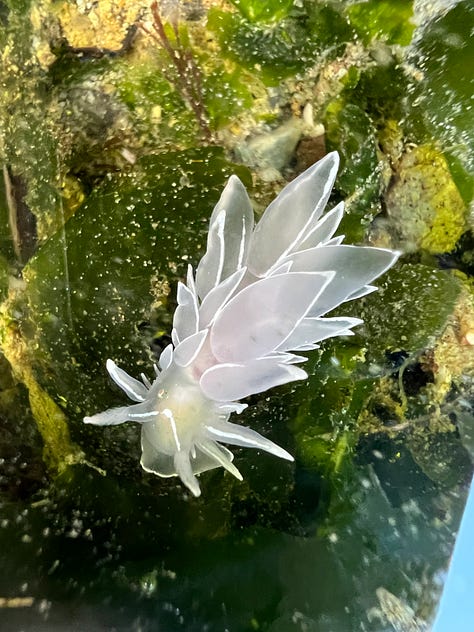


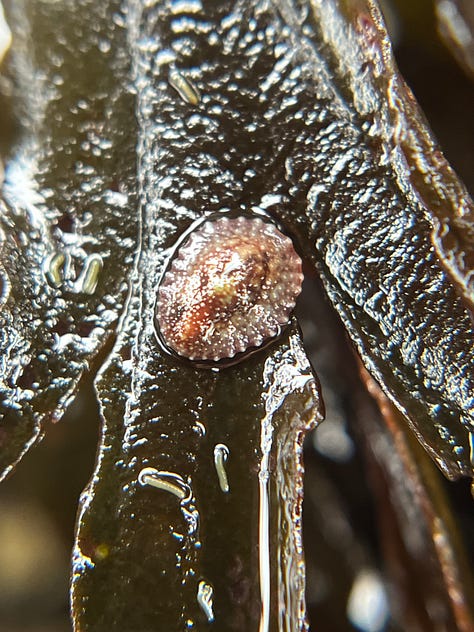
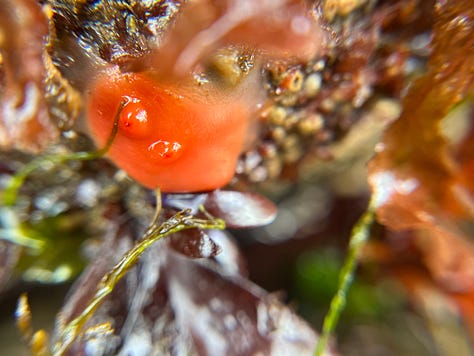

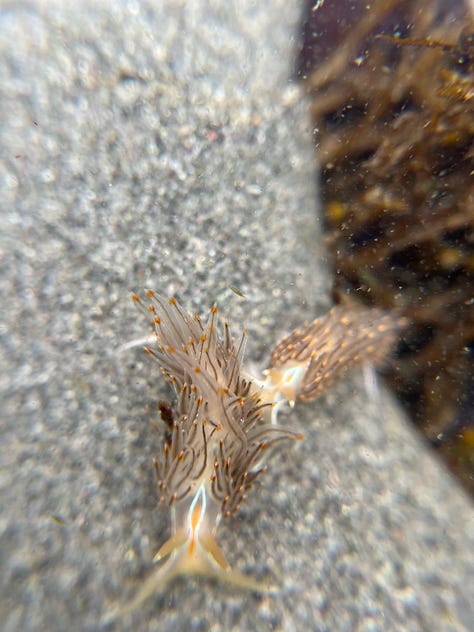
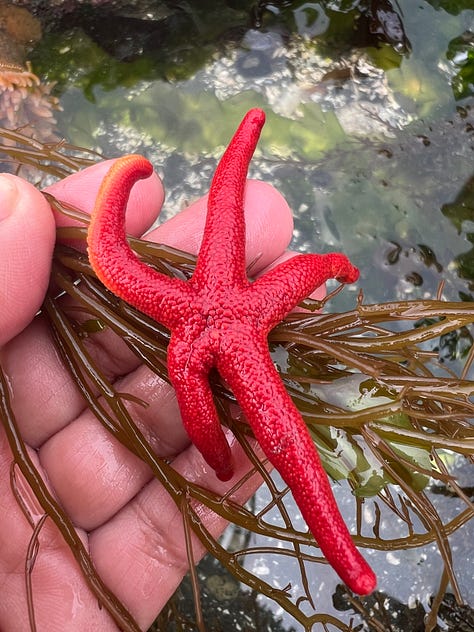
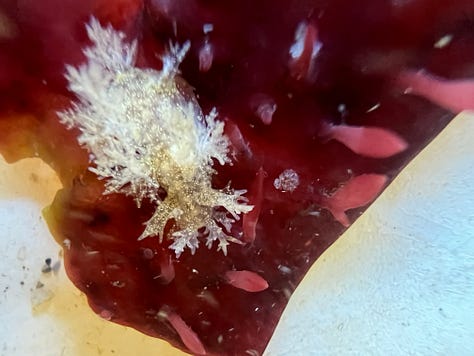
At the end of the month, the low tides in Puget Sound are going to be as low as -4ft in some areas and will occur during the DAY! I’m filled with anticipation for going out and exploring the beach. Once on the beach, I say, “Hello,” out loud to my favorite tide pool creatures as if greeting friends, and “Who are you?” to a creature I’m meeting for the first time. I do this, talking to them as to people, because we humans tend to give better care to those we consider as family. It is a way of reminding myself that I am a PART of - not apart from - nature, that our lives are not isolated but intertwined, and most crucially in that moment, that I am the VISITOR in their home. As a visitor, I want to be kind, respectful and responsible.
If you are planning on visiting the beaches in your area also, here are timeless tips for how you can be a kind, respectful and responsible visitor.1
Tips for being a kind, respectful and responsible beach visitor
One: Step lightly
Two: Observe animals in place and disturb as little as possible.
Three: If you want to, touch with one gentle, wet finger
Four: Ask yourself “What does this animal need?”
Five: Take away only trash (and memories)
Six: Remember that people need kindness to
One: Step lightly on the beach.
Many animals of the intertidal have soft bodies like anemones and cucumbers. Many live or shelter under the looser pebbles and cobbles, like crabs. Soft bodied creatures can tolerate a bit of pressure as longs as we step lightly. Running can disturb the smaller pebbles, under which many crabs and other small arthropods like to hide. Besides, going slow means better chances of spotting something!
Two: Observe animals in place and disturb as little as possible
Naturally, when I find a cool creature, I feel a strong desire to share them with my partner but, if he isn’t right next to me, I call him over to me rather than bringing the creature to him.
Many creatures have specific needs/preferences such as the food they eat or the shelter they need and moving a creature from one spot to another might mean separating them from what they need. The saying we use with school kids is, “Bring the teacher to the creature.” We observe in place so that we aren’t displacing that animal from their desired habitat. We also observe in place to reduce the chance of accidentally dropping them.
Many creatures are found only on the underside of rocks, like flat worms and some chitons, or under the seaweed, like stranded gunnels and other fish. If you want to look under the seaweed, lift gently and put it back as you found. The best practice is to leave bigger rocks- rocks that require two hands and a lot of muscle to shift - completely undisturbed. Shifting big rocks creates a lot of disturbance and can crush shells. If you must peer under a rock, only tilt small hand-sized rocks, without lifting, so that you can gently rock it back into place again, creating the least disturbance. Another saying I learned as a Beach Naturalist is, “Beach Naturalists rock! And we don’t turn them over!” Turning over a rock and leaving it upside down means animals like barnacles, that live on the tops of the rocks, and can’t move, will be unable to get to their food.2 Leaving the underside of rocks exposed also means leaving those creatures that live on the underside more vulnerable to predation.
Three: If you want to, touch with one gentle, wet finger.
A lot of information and connection can be gleaned from touching our intertidal friends. So I encourage you to do so if you are willing. With the exception of the bigger colorful jellyfish such as the Lion’s Mane, octopuses, and large crabs like the Red Rock, most animals will not harm you if you touch them. However, they can easily be harmed by us unless we take care to do it gently. A single wet finger is enough. Touch as if you were petting your eyelashes. Prying a snail or slug off the rocks can damage their body parts so it’s best to refrain from doing this. Remember, “Bring the teacher (or the partner or friend) to the creature.”
Four: Ask yourself “What does this animal need?”
Sometimes we find an animal that we think is in trouble - a crab or snail higher on the beach, a fish stranded in a pool or under seaweed, and we want to help. This is admirable and also tricky. The “Golden Rule” states we should “Treat others as we want to be treated.” But here is where it get’s tricky. Humans and the intertidal creatures have different needs. Even between people, it is tricky. I like to reframe the Golden Rule as “Treat others as THEY want to be treated.”
As pertains to beach creatures, some prefer the higher intertidal area because they breathe air, not water, or can tolerate only brief periods of submersion. Fish have a protective coating on their surface and handling them can compromise this coating. So, before deciding to “rescue” an animal, it’s important to know what they need. Fish in a pool or under moist seaweed are sheltering until the water rises again.
Finding an octopus is, in my mind, a “holy grail” experience as they are one of the hardest creatures to find. They are highly intelligent and adept at hiding in hollows in and under rocks, but they can still get stranded. It is VERY important not to handle an octopus because they can deliver a painful venomous bite.
Octopuses will die if stranded too long. If you find a stranded octopus, first asses the urgency. Is the tide still falling or already rising? How long will the octopus be stranded? If it looks like the octopus will be stranded a long time, one strategy for safe rescue is to create a wet path to the waterline and allow it to crawl back into the water on its own. If you have time and patience, another safe strategy is to keep the octopus moist with sea water until the water rises to meet it again.
Sometimes I find sea stars that have been overturned by a gull (or forgotten by a human)! It’s okay to turn it back over where you found it or put it in a moist spot in the lee of a rock.
Five: Take away only trash (and memories)
At one of our local beaches, there is a poster that reads, “Leave nothing but footprints. Take nothing by memories. Kill nothing but time.” I think this little message says a lot on its own but I’ll elaborate.
Several of our public beaches in Puget Sound are nature preserves where taking anything except trash off the beach is prohibited - not rocks, not sticks, not empty shells, and certainly nothing still alive or containing something alive. Though I adore collecting rocks and shells, I don’t bring them home from the beach anymore.3 Shells, even empty ones, are useful to other animals who might need a home, like the hermit crab. And with our oceans becoming more acidic, it is getting harder for creatures like crabs and snails to grow their shells! Empty shells will dissolve in time, making those minerals available to others once again.
Pebbles are important as spawning habitat for herring, smelt and sand lance. These fish species in turn are vital as food for birds and mammals and bigger fish, like our salmon species. The salmon, in turn, are important food for the orcas (and people). Perhaps you think that one pebble won’t make a difference either way. Maybe it doesn’t. But what if it does? What’s important to remember is that our actions do have consequences and we seldom realize what they are until well after. For me, taking nothing from the beach except trash is a clear “good thing” that causes no harm.
Six: Remember that people need kindness too
Now that you have some tips on how to tide pool with kindness, respect and responsibility for the intertidal animals, remember that people need kindness too. When I see others behaving unaware of the damage they are doing, I feel the need to do something about it, to say something. This is a very tricky thing to do well. Here’s how I approach this situation.4
First, I take a moment to feel empathy. I remember visiting the beach as a child, with pail and shovel, gathering crabs to put in the pail, digging to find the source of that squirt. These are strong and pleasant memories. They are the seeds of my love for the animals now. Remembering that I too did those things, not out of malice but of curiosity helps me to approach someone with compassion.
If you want to show someone a different way, it works best when you already have a trusting relationship. Consider how you would feel if a stranger’s first words to you were, “You shouldn’t be doing that.” Would you be in the space to listen and hear the message? This is why, as a Beach Naturalist with the Seattle Aquarium, I enjoyed interacting with families with young children the most. I can be speaking with the children, who naturally defer to adults, and say, “Let’s make sure to touch with a gentle wet finger” or '“that rock might have a creature living under it so let’s help to keep it safe by leaving it alone.” All the while the adults are hearing the message without being embarrassed.
It’s difficult to be accountable from a place of shame.
-Brene Brown
To an adult friend you can say, “Oh, I used to collect shells too but now I leave them because… ” or “I did this too until I realized that so many things live under the rocks. Let’s put this rock back exactly as we found it.”
I think, there are times when it IS appropriate to say, “Don’t do that!” as when someone might be about to pick up an octopus or touch a Lion’s Mane jellyfish. But I have learned from experience that when someone is not in the space to hear me, they don’t.
It certainly makes me feel sad and frustrated when I see people actively hurting animals. But, without a way to make a trusting connection the chances of my intervention being useful are low. A memorable saying I learned as a public school educator is “connect before I correct.” If I can’t find an easy and authentic way to connect, I focus on modeling the way to be kind and respectful. You never know who will hear you sharing something with your friend. And children are always observing how adults behave and take their cues from what they see their trusted adults doing.
I want to help more people interact with marine animals and ecology in kind and respectful ways and it comforts me to know that I don’t shoulder this burden alone. I know that there are many people who enjoy the beach, have knowledge to share, honor and care about the animals, and have connections with the people they share the beach with. If we go out and bring friends along, we can to pass on what we know in an empathetic and supportive way.5
Sharing is a lot easier in thee app.
A Wild Braid Nature Journal is part of A Wild Braid. The mission of A Wild Braid is to help people experience rest and build resilience through nature journaling, guided nature walks, art, learning and community. Rest and resilience, in turn, makes it possible for us to show up for the people, beings, and planet that we care about.
A Wild Braid is a one-BIPOC-woman owned small business located on Occupied Duwamish and Coast Salish Territory, also known as Seattle, Wa. If you are in my area, the best way to support my work is to take a class. To find a class near you check out my events calendar.
You can also make a donation of any size at www.awildbraid.com/support-donate.
This publication is free! You are welcome to share this publication with friends
These are the tips I learned as a volunteer with the Seattle Aquarium.
Fun fact: Barnacles eat with their feet! They are are attached to rocks “head” down and extend their feet to catch plankton.
I also don’t buy shells commercially collected for decoration because I don’t want to support that market. I do sometimes buy a shell from an antique shop or thrift store because they make good subjects for drawing and my plan is that when I don’t need them anymore, they will go back into the sea.
I learned to hone my intervention and teaching skills from years as a public school educator and, more recently, as staff for the Seattle Aquarium Beach Naturalist and Salmon Naturalist programs.
Because the 25+ year old Seattle Aquarium Beach Naturalist program is ended, there will not be Naturalists on the beach this year but you can find still “free range” naturalists out this summer as we all still want to be on the beach - geeking out with anyone who will listen!







Beautiful, Alma! You shared some super helpful tips. I wasn't aware the beach Naturalist program ended. It sounded like a phenomenal program!